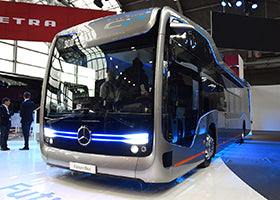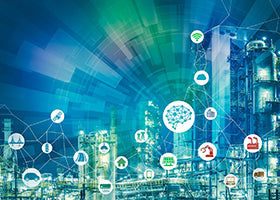
By Athanasios Koutsouridis, Content Marketing Manager
Autonomous mobility has become increasingly important for many industries and we have only just started to see the tip of the iceberg. OEMs and system integrators have observed an increasing demand for automated heavy-duty vehicles such as buses, roboshuttles as well as trucks and are now facing an obligation to deliver.
Transportation companies have been struggling for years to integrate autonomous buses into existing infrastructures and the first commercial tests are still running all around the globe. As AI-driven public transportation picks up in pace, it begs the question of how far we can push the technology in the next ten years and how a driverless shuttle would look in 2035. To make a reliable prediction we will have a look at key factors such as specific use cases, the current state of autonomy, and spec release dates.
|
Roboshuttles and autonomous buses So called roboshuttles are a new piece of reconfigurable tech used for transporting goods and people. At their core they are driverless electric vehicles, moving 8 to 20 passengers in a symmetrical box-shape that makes U-turns obsolete. 5G autopiloted shuttles are currently being tested on public roads in Zhengzhou (China) or Bad Birnbach (Germany) and can be requested via app or control terminal. The total market cap on autonomous shuttles and buses is projected to reach 2.9 billion dollars by 2035, growing at a CAGR of 14.6% from 2026 to 2035, according to an AlliedMarketResearch report on the Semi-Autonomous & Autonomous Bus Market. The key difference between autonomous buses and roboshuttles is usually the level of autonomy. Relevant management regulations of public transport operation have stated that today’s buses require the presence of a driver at any given time. Therefore, a built-in driver seat and conventional controls pose a huge advantage over roboshuttles, because human supervision will most likely be required for at least the next decade. As technology improves, transit companies are gradually training their drivers to monitor autopilot functions during a ride. The sheer size of the current industry poses a huge challenge for autonomous buses. However, major deployments in controlled environments, such as access depots, airports, and urban districts, could be accomplished in just a few years. |
 Within the next ten years, roboshuttles will complement public transportation alongside autonomous buses. |
What is the status quo on driverless buses in public transport?
Merging driverless buses into public transport is a global effort, which has ignited a race among competitors. While start-up companies are not expected to be the main driving forces behind bus automation, their integration of on-demand shuttles into current infrastructures will contribute to public traffic automation on the long run.
Established companies such as Mercedes have already demonstrated concepts of fully self-driving buses since 2016. Last year, the American manufacturer New Flyer has introduced the autonomous transit vehicle Xcelsior AV, which has been dubbed “North America’s first heavy-duty automated transit bus” by NFI Group Inc. president Chris Stoddart. Meanwhile, the city of Málaga (Spain) has been the first place in Europe to run a live-trial of full-sized driverless buses last year, with a maximum capacity of 60 passengers. Furthermore, the city of Toulouse (France) has deployed the self-driving EZ10 on a medical campus, becoming the first authorized roboshuttle to operate fully autonomous on a public road in Europe.
Today’s manufacturers have implemented high-resolution cameras, ultrasonic sensors, short and long-range radar, LiDAR, GPS and similar sensory networks into automated vehicles. The amount of data generated even by current lower level driverless cars can reach several gigabytes per second. It is estimated that a full level-5 autonomous vehicle will produce up to 3,000 times more data, than a non-autonomous does nowadays. With this in mind, buses and other public transit options will be generating even more data, due to additional onboard features such as passenger wi-fi and detection as well as fully-automatic ticketing systems. OEMs and manufacturers will have to deploy high-bandwidth edge computers, in order to ensure a safe operation at all times. As a world leader for ruggedized GPU-accelerated servers, One Stop Systems (OSS) has launched the very first industrial-grade PCIe Gen5 GPU Accelerator for emerging mass transit markets and any AI-driven transportable application.

How far can AI performance be pushed by 2035?
According to the current PCI-SIG® road map, I/O bandwidth doubles approximately every 3 years (see graph). However, we have to consider an additional 3- to 5-year gap between the spec release and actual working appliances in industrial environments. Following up on this, we can expect that PCIe Gen7 will hit the market with 512Gbps for x16 lanes in 2030, with new releases up to 1Tbps being in the pipeline by 2035. New backplanes along with upcoming improvements in GPUs, CPUs and DPUs will open up huge opportunities for level-5 autonomous driving in the future.
New manufacturing processes for semiconductors will keep Moore’s Law valid until 2036, paving the way for transistors with a size less than a nanometer. Due to these developments, we predict an embedded AI computer, which, by 2035, might reach a performance of up to 3 exaflops (1018 flops) or higher. If we look at an enterprise-level AI data center platform like today’s 140-system clusters, we would even be able to accumulate a supercomputer with at least 420 exaflops of raw AI performance.
What might a bus look like in 2035 and how would it tie into public traffic?
With this unprecedented level of performance available by 2035, thousands of autonomous buses will have merged into public traffic, along with several hundred roboshuttles in closed-off environments. We are expecting a mix of both electric and hydrogen-fueled shuttles, operating on pre-mapped routes across major city districts and airports. Highly-advanced hardware will perform multi-level tasks on-board with minimal space requirement, at a maximum performance.
A transportation vehicle of this magnitude will feature level-5 self-driving capabilities with no human interference and a communication system connected to a traffic management center via 6G. High-level autonomous vehicle perception sensors all around the bus will generate an advanced view field, including 360° mapped 3D environments, depth information and object recognition. This massive amount of data will be stored and processed using ultra-advanced HPC edge solutions. Interconnected autonomous bus fleets will train and update entire software models for each vehicle within seconds, depending on the collected traffic data.
Autonomous buses will also have to manage wi-fi networks and wireless charging options for smart devices as well as digital signage systems displaying GPS location, upcoming bus stops and delays in real-time. Passengers will be able to purchase their tickets and pre-determine their bus stop via app, increasing efficiency for a smoother traffic experience. Integrated security cameras can detect every person in close proximity of the doors and within the bus, in order to verify their identity and ticket, avoiding fare evasion and increasing overall safety in public vehicles.
With future-proof AI-powered driverless buses and shuttles, traffic jams, fatal accidents and carbon dioxide emissions will see a decrease. In the meantime, increasing urbanization and smarter cities will cause a higher demand for self-driving vehicles. In conclusion, autonomous buses in 2035 have a high potential of revolutionizing automated mass transit systems, shifting more loads from individual traffic onto public transportation.
Click the buttons below to share this blog post!
Comments will be approved before showing up.


